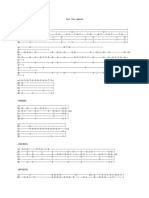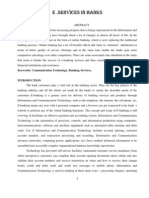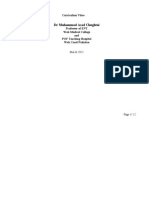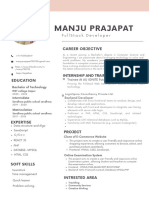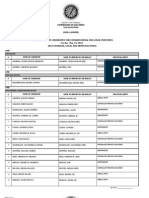Classifications of Dances
Classifications of Dances
Uploaded by
Eli Harris0 ratings0% found this document useful (0 votes)
33 views1 pageThis document provides an overview of 12 different dance styles: ballet, jazz dancing, tap dance, hip-hop dance, modern dance, swing dancing, contra dance, country and western, belly dancing, flamenco, Latin dance, and folk dance. It describes the origins, characteristic movements, music, and key differences of each style in 1-2 sentences.
Original Description:
Copyright
© © All Rights Reserved
Available Formats
DOCX, PDF, TXT or read online from Scribd
Share this document
Did you find this document useful?
Is this content inappropriate?
Report this DocumentThis document provides an overview of 12 different dance styles: ballet, jazz dancing, tap dance, hip-hop dance, modern dance, swing dancing, contra dance, country and western, belly dancing, flamenco, Latin dance, and folk dance. It describes the origins, characteristic movements, music, and key differences of each style in 1-2 sentences.
Copyright:
© All Rights Reserved
Available Formats
Download as DOCX, PDF, TXT or read online from Scribd
Download as docx, pdf, or txt
0 ratings0% found this document useful (0 votes)
33 views1 pageClassifications of Dances
Classifications of Dances
Uploaded by
Eli HarrisThis document provides an overview of 12 different dance styles: ballet, jazz dancing, tap dance, hip-hop dance, modern dance, swing dancing, contra dance, country and western, belly dancing, flamenco, Latin dance, and folk dance. It describes the origins, characteristic movements, music, and key differences of each style in 1-2 sentences.
Copyright:
© All Rights Reserved
Available Formats
Download as DOCX, PDF, TXT or read online from Scribd
Download as docx, pdf, or txt
You are on page 1of 1
Classifications of Dances: 8.
Country and Western: Country and western dance is a
1. Ballet: Ballet originated in the 15th century, first in Italy and broad category of many dance styles, incorporating influences from
then in France. Over the centuries, ballet has influenced many other contra, folk, and even jazz, set to country or western-themed dance
styles of dance and become a fine art form in its own right. There music. Waltzes and two-steps are the most common forms of
are three basic styles: partner-style dancing, but you'll also find variations on polkas and
Classical: This form reached its peak in 19th-century France and other folk dances brought to the U.S. by German and Czech
Russia. It is often story-driven and orchestrated ("The Nutcracker" is immigrants. Square dances and line dances, where people dance in
a great example), with fantastical sets and costumes. The movement tight, choreographed movements with a number of partners or as
emphasizes point work (dancing on toes), graceful expressions, and part of a group, have their roots in contra dancing. Clog dancing, a
symmetry among dancers. form of footwork-heavy dance rooted in the jigs of Britain and
Neoclassical: This is an evolution of classical ballet, which emerged Ireland, is most frequently associated with bluegrass music.
in the early to mid-20th century. Movements are faster and more 9. Belly Dancing: Belly dancing emerged from the folk
urgent, with less emphasis on symmetry, and simple sets and traditions of the Middle East, but its precise origins are unclear.
costumes. The plot is often nonexistent. Orchestras, bands, or Unlike most forms of Western dancing, which emphasize complex
soloists may accompany the dancers. footwork and partner choreography, belly dancing is a solo
Contemporary: Like neoclassical, the plot is cast aside in favor of performance that focuses on the torso and hips. Dancers combine a
pure movement and physical expression, which may not appear to series of fluid movements to emphasize rhythm, isolated flourishes
be dancelike at all. Costumes and set designs are frequently simple like hip twists for percussive punctuation, and shimmies, spins, and
or abstract. Music or sound work, if used, is often contemporary or torso vibrations to add variety and detail.
experimental in nature. 10. Flamenco: Flamenco dance is an expressive dance form that
2. Jazz Dancing: Jazz is a lively dance style that relies heavily on mixes percussive footwork with intricate hand, arm, and body
originality and improvisation. This style often uses bold, dramatic movements. It emerged from the cultures of the Iberian Peninsula in
body movements, including body isolations and contractions. Jazz the 1700s and 1800s, though its precise origins are unclear.
dance has its roots in African traditions kept alive by slaves brought Flamenco consists of three elements: cante (the song), baile (the
to the U.S. Over time, this evolved into a style of street dance that dance), and guitarra (guitar playing). Each has its own traditions, but
soon moved into the jazz clubs of the early 20th century. the dancing is most often closely associated with flamenco, with its
3. Tap Dance: Like jazz dancing, tap evolved from the African flamboyant gestures and rhythmic foot stamping that calls to mind
dance traditions preserved by slaves in the U.S. In this exciting dance tap dancing.
form, dancers wear special shoes equipped with metal taps. Tap 11. Latin Dance: Latin dance is a broad term for any number of
dancers use their feet like drums to create rhythmic patterns and ballroom and street-style dance forms that evolved in the 19th and
timely beats. Music is rarely used. 20th centuries in the Spanish-speaking Western Hemisphere. These
4. Hip-Hop Dance: Another descendant of jazz dance, hip-hop styles have roots in European, African, and indigenous dance and
emerged from the streets of New York in the 1970s in the city's ritual. Many styles of Latin dance have their origins in a specific
African-American and Puerto Rican communities at the same time as region or country. Tango, with its sensual, close partnerships,
rap and DJing. Breakdancing—with its popping, locking, and athletic originated in Argentina. Salsa, with its hip-swaying beat, evolved in
floor movements—is perhaps the earliest form of hip-hop dance. the Puerto Rican, Dominican, and Cuban communities of 1970s New
Often, "crews" of teams of dancers would hold competitions to see York City. Other popular forms of Latin dance include Mambo, which
which group had bragging rights as the best. originated in 1930s Cuba; bomba, a folk-style of rhythmic dance
from Puerto Rico; and meringue, a Dominican style of close partner
5. Modern Dance: Modern dance is a dance style that rejects dancing with tight hip movements.
many of the strict rules of classical ballet, focusing instead on the
expression of inner feelings. It emerged in Europe and the U.S. in the 12. Folk Dance: Folk dance is a generic term that can refer to a
early 20th century as a rebellion against classical ballet, emphasizing variety of dances developed by groups or communities, as opposed
creativity in choreography and performance. to being made up by a choreographer. These forms often evolve
over generations and are learned informally, usually at communal
6. Swing Dancing: Swing dance is yet another offshoot of gatherings where the dances are performed. Music and costuming
traditional jazz dance that became popular as swing bands became often reflect the same ethnic traditions of the dancers. Examples of
the dominant form of popular entertainment in the late 1930s and folk dances include the rigid uniformity of Irish line dancing and the
early '40s. Unlike other forms of jazz dance that emphasize the call-and-response interplay of a square dance.
individual, swing dance is all about partnership. Athletic couples
00:35
swing, spin, and jump together in syncopated time to the beat of the
00:35
band, usually with a fixed number of choreographed steps repeated
in a specific sequence.
7. Contra Dance: Contra dance is a form of American folk
dance in which the dancers form two parallel lines and perform a
sequence of dance movements with different partners down the
length of the line. It has its roots in similar folk dances from colonial-
era Great Britain. Although contra dancing is partner-based, it's a
communal arrangement; you don't need to bring your own partner,
because you'll be dancing with everyone down the line at some
point. Dancers are led by a caller, who calls out specific steps and
directions to change partners. Folk music from the British Isles or the
U.S. is the most common form of accompaniment.
You might also like
- His Blue Moon Princess by Jenny FoxDocument157 pagesHis Blue Moon Princess by Jenny Foxthriftyshoplb1Noch keine Bewertungen
- Muscle Evolution Posing Handbook PDFDocument17 pagesMuscle Evolution Posing Handbook PDFEli HarrisNoch keine Bewertungen
- Dance History Timeline: Dance. A Celebration ofDocument1 pageDance History Timeline: Dance. A Celebration ofGiselle MartinezNoch keine Bewertungen
- Group 1 - African American DanceDocument59 pagesGroup 1 - African American DanceJenelle CalansinginNoch keine Bewertungen
- 12 Popular Types of DanceDocument5 pages12 Popular Types of DanceHasz RonquilloNoch keine Bewertungen
- Types of Dances (Ctto)Document6 pagesTypes of Dances (Ctto)Ms Perfecty (JZ)Noch keine Bewertungen
- Types of DanceDocument6 pagesTypes of DanceSoliel RiegoNoch keine Bewertungen
- DANCEDocument25 pagesDANCEShae ShaeNoch keine Bewertungen
- Kinds of DanceDocument4 pagesKinds of DanceSon YongNoch keine Bewertungen
- G12 Pe3Document5 pagesG12 Pe3Paula Maureen PaglinawanNoch keine Bewertungen
- Folk DanceDocument4 pagesFolk DanceCeejay TimbrezaNoch keine Bewertungen
- Ballroom DancingDocument6 pagesBallroom DancingAngela Bainca AmperNoch keine Bewertungen
- PDocument8 pagesPJanel Lim PinqueNoch keine Bewertungen
- Dance GenresDocument2 pagesDance GenresMahilum, Aira C.Noch keine Bewertungen
- Hand Outs For Midterm.Document6 pagesHand Outs For Midterm.Ashley GozonNoch keine Bewertungen
- Origin of Dance FM 2Document5 pagesOrigin of Dance FM 2Hanna Jane TigsonNoch keine Bewertungen
- Street Dance Has Its Origins in African American CultureDocument13 pagesStreet Dance Has Its Origins in African American CultureJelly Rose RellesivaNoch keine Bewertungen
- Types of Dance - Categories: Ballroom DancesDocument12 pagesTypes of Dance - Categories: Ballroom DancesJake Floyd MoralesNoch keine Bewertungen
- Types of DanceDocument10 pagesTypes of Danceschoolais21Noch keine Bewertungen
- Ballroom DanciinngggDocument4 pagesBallroom DanciinngggAngela Bainca AmperNoch keine Bewertungen
- Jene Rose Pagayon BSACTY-2 Stubcode: 1051 What Is Dance? Dance Is A Performing Art. It Is Described in Many Ways. It Is WhenDocument3 pagesJene Rose Pagayon BSACTY-2 Stubcode: 1051 What Is Dance? Dance Is A Performing Art. It Is Described in Many Ways. It Is WhenJene Rose PagayonNoch keine Bewertungen
- Different Types of Dances: Submitted By: Submitted ToDocument2 pagesDifferent Types of Dances: Submitted By: Submitted ToNixieHidalgoNoch keine Bewertungen
- Project: Physical EducationDocument8 pagesProject: Physical EducationZorem Jee F. MurillonNoch keine Bewertungen
- Group 3Document42 pagesGroup 3jemimahmelodiasNoch keine Bewertungen
- MODULE 3 Dance Towards The 21st CentruyDocument7 pagesMODULE 3 Dance Towards The 21st Centruygarciakirk9Noch keine Bewertungen
- Social Dance: Social Dance Is A Category of Dances That Have A Social Function andDocument5 pagesSocial Dance: Social Dance Is A Category of Dances That Have A Social Function andalmira calaguioNoch keine Bewertungen
- Social DanceDocument14 pagesSocial DanceChem Jayder Masilang CabungcalNoch keine Bewertungen
- Types of DanceDocument11 pagesTypes of DanceRey TrinidadNoch keine Bewertungen
- American Folk DancesDocument8 pagesAmerican Folk DancesScribdTranslationsNoch keine Bewertungen
- Dance ArtttsssssDocument78 pagesDance ArtttsssssJean Rose Tabagay BustamanteNoch keine Bewertungen
- Dance Forms Lesson 13Document8 pagesDance Forms Lesson 13nosjay 16Noch keine Bewertungen
- Dances Ballet Is A Type Of: Cante ToqueDocument2 pagesDances Ballet Is A Type Of: Cante ToqueDaniela Arsenova LazarovaNoch keine Bewertungen
- TOPIC: Different Genres of Dances: Principal Soloist Corps de BalletDocument4 pagesTOPIC: Different Genres of Dances: Principal Soloist Corps de BalletDanielle AdvinculaNoch keine Bewertungen
- DanceDocument2 pagesDanceKeziah O. BarrientosNoch keine Bewertungen
- Ballroom DancesDocument4 pagesBallroom DancesJake MallorcaNoch keine Bewertungen
- DANCEDocument26 pagesDANCEJasmin BajenNoch keine Bewertungen
- History of Ballroom DancingDocument7 pagesHistory of Ballroom DancingJosh Cruz100% (1)
- Ballroom Dances PPT 8 To 10 RhythmicDocument14 pagesBallroom Dances PPT 8 To 10 RhythmicGelay MendozaNoch keine Bewertungen
- History of Ballroom Dance: Partner Dances Socially Competitively PerformanceDocument3 pagesHistory of Ballroom Dance: Partner Dances Socially Competitively PerformanceJay PeeNoch keine Bewertungen
- Type of DanceDocument7 pagesType of DanceRubdubRNoch keine Bewertungen
- HOPEDocument12 pagesHOPEPark RiRinNoch keine Bewertungen
- Popular Types of Dance: BalletDocument5 pagesPopular Types of Dance: BalletAura mae valmonteNoch keine Bewertungen
- Dance - Group 3Document14 pagesDance - Group 3Un DoneNoch keine Bewertungen
- P E-ReviewerDocument15 pagesP E-Reviewerdarkenthemaster010Noch keine Bewertungen
- ART APPRECIATION DancesDocument22 pagesART APPRECIATION DancesMARC DARIO MALAZZABNoch keine Bewertungen
- 1 Types of DanceDocument2 pages1 Types of DanceGreBaptistChristianPre-SchoolNoch keine Bewertungen
- Lecture Dancing-1Document9 pagesLecture Dancing-1AngelNoch keine Bewertungen
- Module 6: Ballroom Dancing: LEARNING OUTCOME: at The End of The Chapter, The Learner Will Be Able ToDocument2 pagesModule 6: Ballroom Dancing: LEARNING OUTCOME: at The End of The Chapter, The Learner Will Be Able To56jhdkiNoch keine Bewertungen
- PE MergedDocument35 pagesPE MergedJulie CabusaoNoch keine Bewertungen
- PE2 Written Report Group 1Document8 pagesPE2 Written Report Group 1Neritchel AndoniNoch keine Bewertungen
- History of Social DanceDocument4 pagesHistory of Social DanceSharnelle Valdez NotoNoch keine Bewertungen
- Different Kind of DancesDocument30 pagesDifferent Kind of Dancesanya85% (13)
- Vigo, Mark Bernard P. Bsit Ds-12: BalletDocument8 pagesVigo, Mark Bernard P. Bsit Ds-12: BalletMark VigoNoch keine Bewertungen
- Ball Room DanceDocument11 pagesBall Room Dancegerbbyaragon125Noch keine Bewertungen
- Pe l2 HandoutDocument6 pagesPe l2 HandoutJuliana BrockNoch keine Bewertungen
- Ballet Folk Modern DanceDocument23 pagesBallet Folk Modern DanceAbdulrahman SuangaNoch keine Bewertungen
- P.E 2 Tue Jan 30Document22 pagesP.E 2 Tue Jan 30Minako AinoNoch keine Bewertungen
- Hope Report g3 CompressedDocument60 pagesHope Report g3 Compressedv5pqybmc9pNoch keine Bewertungen
- BALLROOMDocument11 pagesBALLROOMDianaGrace DionisioNoch keine Bewertungen
- Different Genres of DanceDocument7 pagesDifferent Genres of DanceGina CruzNoch keine Bewertungen
- Kinds of DancesDocument57 pagesKinds of DancesDemi Dorothy100% (1)
- City Folk: English Country Dance and the Politics of the Folk in Modern AmericaFrom EverandCity Folk: English Country Dance and the Politics of the Folk in Modern AmericaNoch keine Bewertungen
- RVE Putting God FirstDocument1 pageRVE Putting God FirstEli HarrisNoch keine Bewertungen
- Class No. M15 Date: 12/18/2020 Score: - / 70 Family Name, Given Name: Pangulayan, Valkyrie Ben Andrei B. Grade & Section 11 STEMC St. Frances of RomeDocument3 pagesClass No. M15 Date: 12/18/2020 Score: - / 70 Family Name, Given Name: Pangulayan, Valkyrie Ben Andrei B. Grade & Section 11 STEMC St. Frances of RomeEli HarrisNoch keine Bewertungen
- January - Rve 11 B Performance Check No 3 1ST Grading - Second SemesterDocument3 pagesJanuary - Rve 11 B Performance Check No 3 1ST Grading - Second SemesterEli HarrisNoch keine Bewertungen
- Title of The Study/author/ Publisher/Year of Publication Research Problem Research Objectives Research Methods/ Approach/ Designs Variables IncludedDocument9 pagesTitle of The Study/author/ Publisher/Year of Publication Research Problem Research Objectives Research Methods/ Approach/ Designs Variables IncludedEli HarrisNoch keine Bewertungen
- Shoulder Hypertrophy Specialization ProgramDocument3 pagesShoulder Hypertrophy Specialization ProgramEli Harris100% (1)
- Electronic Contribution Collection List SummaryDocument2 pagesElectronic Contribution Collection List SummaryEli HarrisNoch keine Bewertungen
- 10 MatrixDocument16 pages10 MatrixEli HarrisNoch keine Bewertungen
- Electronic Contribution Collection List SummaryDocument2 pagesElectronic Contribution Collection List SummaryEli HarrisNoch keine Bewertungen
- Strictly, No Erasures or Superimpositions of Any Kind For Test I or Else Your Answers Will Be Considered InvalidDocument7 pagesStrictly, No Erasures or Superimpositions of Any Kind For Test I or Else Your Answers Will Be Considered InvalidEli HarrisNoch keine Bewertungen
- Barriers To Learning in Distance EducationDocument24 pagesBarriers To Learning in Distance EducationEli HarrisNoch keine Bewertungen
- Full Body Workout SplitDocument1 pageFull Body Workout SplitEli HarrisNoch keine Bewertungen
- Gulay SongDocument1 pageGulay SongEli HarrisNoch keine Bewertungen
- See You AgainDocument2 pagesSee You AgainEli HarrisNoch keine Bewertungen
- Ref 005986Document3 pagesRef 005986Alex FulgaNoch keine Bewertungen
- NICL Annual Report 2017-18 PDFDocument230 pagesNICL Annual Report 2017-18 PDFDivyanshu MalikNoch keine Bewertungen
- Teacher Reflection Form For MT I-IV For RPMS SY 2021-2022 With ANSWERDocument8 pagesTeacher Reflection Form For MT I-IV For RPMS SY 2021-2022 With ANSWERmaria christina serenoNoch keine Bewertungen
- Harvesting Indices of VegetablesDocument7 pagesHarvesting Indices of VegetablesDr.Eswara Reddy Siddareddy100% (3)
- Effect of "Jago Grahak Jago" Communication Campaigns in India To Increase Consumer AwarenessDocument5 pagesEffect of "Jago Grahak Jago" Communication Campaigns in India To Increase Consumer AwarenessAshuNoch keine Bewertungen
- E .Services in Banks: Keywords: Communication Technology, Banking, ServicesDocument10 pagesE .Services in Banks: Keywords: Communication Technology, Banking, ServicesDr.K.BaranidharanNoch keine Bewertungen
- Topnotch Surgery Reviewer PDFDocument81 pagesTopnotch Surgery Reviewer PDFkat0% (1)
- DR Muhammad Asad Chughtai: Curriculum VitaeDocument9 pagesDR Muhammad Asad Chughtai: Curriculum Vitaemuhammad chughtaiNoch keine Bewertungen
- S.No. Branch Code AD Code Branch Name Sub Branch City NameDocument9 pagesS.No. Branch Code AD Code Branch Name Sub Branch City Namemalik umarNoch keine Bewertungen
- Build Your Own Resume Parser Using Python and NLP - APILayerDocument12 pagesBuild Your Own Resume Parser Using Python and NLP - APILayerrajikareNoch keine Bewertungen
- Product Development Chapter 1Document17 pagesProduct Development Chapter 1Murni Sahdan100% (1)
- Course File: Design of Machine Members-IiDocument30 pagesCourse File: Design of Machine Members-IiSamiullah MohammedNoch keine Bewertungen
- 3 PDFDocument2 pages3 PDFAbdiasisNoch keine Bewertungen
- Pareto EfficiencyDocument6 pagesPareto EfficiencyJennybabe PetaNoch keine Bewertungen
- BENEFITS OF BALLROOM DancingDocument15 pagesBENEFITS OF BALLROOM DancingJojo JojoNoch keine Bewertungen
- SAHIR KHAN Notes Class 1Document17 pagesSAHIR KHAN Notes Class 1MuhammadAwaisKhalidNoch keine Bewertungen
- About This Sample: TEC Order Management RFI/RFP TemplateDocument17 pagesAbout This Sample: TEC Order Management RFI/RFP TemplateTamim TamimNoch keine Bewertungen
- Optimized System For Your Bottom Line - Dennis NGDocument55 pagesOptimized System For Your Bottom Line - Dennis NGnobleNoch keine Bewertungen
- Offical ManjuCVDocument1 pageOffical ManjuCVmoubais3143Noch keine Bewertungen
- WLPL Vehicle Management SOP:: 2. Terms and ConditionsDocument16 pagesWLPL Vehicle Management SOP:: 2. Terms and Conditionsankit singhNoch keine Bewertungen
- Rolls Royce A Case Study by Wahid311Document3 pagesRolls Royce A Case Study by Wahid311Abdul Wahid Khan100% (2)
- Luna, La UnionDocument2 pagesLuna, La UnionSunStar Philippine NewsNoch keine Bewertungen
- Wa2870 14 10 03 2015Document5 pagesWa2870 14 10 03 2015PreethaNoch keine Bewertungen
- Annex 4 Word FormatDocument2 pagesAnnex 4 Word FormatWylie A. BaguingNoch keine Bewertungen
- IELTS Speaking Mock Test 1Document8 pagesIELTS Speaking Mock Test 1Nguyễn Ngọc Minh AnhNoch keine Bewertungen
- Chapter 12Document21 pagesChapter 12NurdianAsriNoch keine Bewertungen
- Witp Manual (Ebook)Document332 pagesWitp Manual (Ebook)Luigi AmendolaNoch keine Bewertungen
- HappinessDocument10 pagesHappinessTan Zheng Yu100% (1)
- 1.2ms Test by Mrs - Benghalia.cDocument5 pages1.2ms Test by Mrs - Benghalia.cMouloud RahmaniNoch keine Bewertungen










































































